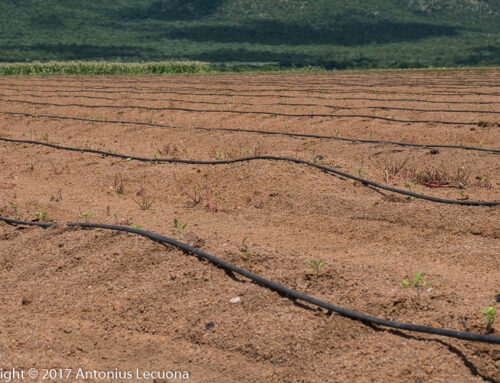On commercial farms the most common method of planting is with precision planters. These planters can be set according to the size of the bean and the planting density required in the field. The most uniform yields are achieved this way compared to hand planting.
As soon as the bean seed is planted overhead irrigation should start. The top crust of the soil must be kept soft and not too warm so that the seedling can push through. If a hard crust forms the soft seedling will bend down in the soil and die. Crust formation is problematic in sandy soils.
Some varieties can tolerate heat but few can tolerate extreme soil temperatures. Make sure there is enough irrigation water during the hottest time of the day.
Seed must be planted no deeper than 50 mm. Any variation in planting depth will result in growth and yield variations. This is particularly a problem if the plants are harvested mechanically.
Soil preparation for green beans
The precise procedures for tilling soil is not within the scope of this article. Each soil characteristics must be taken into consideration with the available implements and machinery. What is important is that most growers prepare ridges on which the beans are planted.
The width of the ridge is usually determined by the planter available. Not the other way around. In general growers have three rows on a ridge each spaced about 200 mm from each other. The plants are spaced between 150 – 200 mm apart.
The ridges distance is determined by the equipment, but in general it is 500-700 mm apart, from side of the ridges.

Ideally beans should be planted on ridges. Depending on equipment and harvesting method, there can be 1-3 rows on top of a ridge. Seed must not be deeper than 50 mm.
Planting densities of commercial green beans
In general, one aims to achieve 200 000 plants per ha. If you land faces north this is easy to achieve, however, south or east facing landscapes will require slightly lower planting densities due to less light penetrating the plant canopy. A grower will quickly notice if the planting density is too high by looking at the growth of the plant. Spindly plants with long stems indicate light competition so the plant spacing must be decreased, or total plants per hectare reduced.
Spacing of green beans in the field:
- In row spacing: 20-25 plants per meter or 4-5 cm between plants.
- Space between rows: That depends on the equipment and planter you are using. Some growers use only one row, others two or even three rows per bed. So the space between the rows will depend on the width of the tractor making the ridges and planting the seed.
- Depending on seed size, planting density etc etc, between 40-50 kg seed is used per ha.
- The grower has to compensate for germination % as well. So if you have 90% germination rate, the seed/ha increases to 44.5 – 55.6 kg/ha.

Green beans can also be planted in single rows or more. In this case single rows are chosen with overhead irrigation. Depending on planting and harvesting equipment, a triple row is possible. The best is to trial each planting method and see which method provides the best results in terms of yield, quality and easy of use.
Planting density of homegrown green beans
Growing green beans at home is actually very easy. For easy harvesting plant them in double rows, about 200-300 mm apart and 200 mm within the row. Don’t grown the plants too close to each other. It will just increase the disease pressure and provide an ideal cover for insects. Home growers do not have industrial mist blowers to control pests and diseases as efficiently as back sprays.






Leave A Comment
You must be logged in to post a comment.